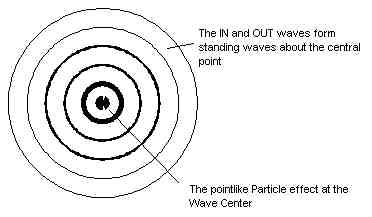Albert Einstein's Theory of Relativity
Physics: Albert Einstein's Theory of Relativity
Simplifying the Metaphysics of Einstein's Special and General Relativity
 When forced to summarize the general theory of relativity in one sentence:
When forced to summarize the general theory of relativity in one sentence:
Time and space and gravitation have no separate existence from matter.
(Albert Einstein)
 Physical objects are not in space, but these objects are spatially extended (as fields). In this way the concept 'empty space' loses its meaning. ... The field thus becomes an irreducible element of physical description, irreducible in the same sense as the concept of matter (particles) in the theory of Newton. ... The physical reality of space is represented by a field whose components are continuous functions of four independent variables - the co-ordinates of space and time. Since the theory of general relativity implies the representation of physical reality by a continuous field, the concept of particles or material points cannot play a fundamental part, nor can the concept of motion. The particle can only appear as a limited region in space in which the field strength or the energy density are particularly high. (Albert Einstein, Metaphysics of Relativity, 1950)
Physical objects are not in space, but these objects are spatially extended (as fields). In this way the concept 'empty space' loses its meaning. ... The field thus becomes an irreducible element of physical description, irreducible in the same sense as the concept of matter (particles) in the theory of Newton. ... The physical reality of space is represented by a field whose components are continuous functions of four independent variables - the co-ordinates of space and time. Since the theory of general relativity implies the representation of physical reality by a continuous field, the concept of particles or material points cannot play a fundamental part, nor can the concept of motion. The particle can only appear as a limited region in space in which the field strength or the energy density are particularly high. (Albert Einstein, Metaphysics of Relativity, 1950)
 Physics constitutes a logical system of thought which is in a state of evolution, whose basis (principles) cannot be distilled, as it were, from experience by an inductive method, but can only be arrived at by free invention. The justification (truth content) of the system rests in the verification of the derived propositions (a priori/logical truths) by sense experiences (a posteriori/empirical truths). ... Evolution is proceeding in the direction of increasing simplicity of the logical basis (principles). .. We must always be ready to change these notions - that is to say, the axiomatic basis of physics - in order to do justice to perceived facts in the most perfect way logically. (Albert Einstein, Physics and Reality, 1936)
Physics constitutes a logical system of thought which is in a state of evolution, whose basis (principles) cannot be distilled, as it were, from experience by an inductive method, but can only be arrived at by free invention. The justification (truth content) of the system rests in the verification of the derived propositions (a priori/logical truths) by sense experiences (a posteriori/empirical truths). ... Evolution is proceeding in the direction of increasing simplicity of the logical basis (principles). .. We must always be ready to change these notions - that is to say, the axiomatic basis of physics - in order to do justice to perceived facts in the most perfect way logically. (Albert Einstein, Physics and Reality, 1936)
Introduction
I am currently re-writing all the main pages on this website to simplify them / make them a bit more human friendly. I realise this page is quite long - but it contains a very good summary of the evolution of Physics and how this led to Einstein's theory of relativity. Most importantly it shows how we can simplify his foundations of representing matter as continuous fields in space-time, to waves in continuous space. It is actually a very simple obvious solution once realised - but like all things it takes a while to adjust to new knowledge. It does lead to a very simple sensible foundation for understanding physical reality, and thus how you exist in the universe. So I think it is worth the effort!
Geoff Haselhurst
The development during the present century is characterized by two theoretical systems essentially independent of each other: the theory of relativity and the quantum theory. The two systems do not directly contradict each other; but they seem little adapted to fusion into one unified theory. For the time being we have to admit that we do not possess any general theoretical basis for physics which can be regarded as its logical foundation. (Albert Einstein, 1940)
As is well known, there are two fundamental theories which are the pillars of modern Physics - Albert Einstein's Special and General Relativity (1905, 1915) and Quantum Theory (1900-1930). Further, Albert Einstein's General Relativity (on Gravitation and accelerated motion) then laid the foundations for modern Cosmology (as gravity is a phenomena that extends across the universe - though we now realise that charge also plays a significant role in the evolution of the universe).
Now it is also universally known that Albert Einstein's Relativity Theory is famous for being incomprehensible. And it even seems that some scientists enjoy this incomprehensibility of the universe. However, philosophy teaches us that things become absurd when we have errors in our language and metaphysical foundations. Thus the solution is not to have endless arguments (and amusements) over these absurdities, but rather, to go back to the foundations and ensure that you have not made any errors.
 Having done this, it is clear that there is in fact a more simple way of describing reality than Einstein's assumption of Continuous Fields in Space-Time. While Einstein was correct in rejecting the 'particle' concept we now realise that the 'continuous field' concept (i.e. Faraday, Maxwell, Lorentz, and which Einstein used in his Theory of Relativity) is also incorrect.
Having done this, it is clear that there is in fact a more simple way of describing reality than Einstein's assumption of Continuous Fields in Space-Time. While Einstein was correct in rejecting the 'particle' concept we now realise that the 'continuous field' concept (i.e. Faraday, Maxwell, Lorentz, and which Einstein used in his Theory of Relativity) is also incorrect.
Instead, it is simpler (and solves many problems) to describe reality from One thing existing, Space, and its Properties as a Wave Medium for Spherical Waves that form Matter. This is explained in the articles listed at the top of this page.
So you will find our pages a little different than most, because we are describing reality (and thus explaining Albert Einstein's Theory of Relativity) from a slightly different foundation than the current paradigm of 'particles' and 'fields' in 'Space-Time', to a more simple foundation of Spherical Standing Waves in Space. And we are describing a theory that can now be sensibly understood (so if you want absurdity and its sensations that postmodern physics seems to enjoy, this is not a good website for you.)
Though I am primarily a philosopher / metaphysicist I have read Einstein a great deal, he is probably the philosopher / scientist whom I have most affection for (and I do have great affection for many philosophers). And one thing that Einstein understood well was the importance of understanding the history and evolution of knowledge. As a philosopher strongly influenced by evolution, I cannot agree more, that it is critical (and now neglected) to study the history and evolution of knowledge if we are to correctly understand it, and thus have any hope of correcting the errors (and there are clearly many errors in modern physics, as there are in philosophy and metaphysics).
Certainly, by understanding the foundation of knowledge in physics at the time Einstein developed his theory of relativity, we can now easily understand why he chose the path of representing matter as Continuous Spherical 'Fields' in Space-Time. And of most significance we can now also understand how there is a more simple solution, by describing matter in terms of Spherical Waves in Continuous Space, that clearly explains and solves the problems caused by Einstein's failure to find a pure 'field theory of matter'.
Thus we must begin by considering the evolution of the main ideas and concepts that lay at the metaphysical foundations of Albert Einstein's Theory of Relativity. i.e. Newton's Mechanics (1687), Faraday's Electromagnetic Field Theory (1832), Maxwell's Equations (1876) and Lorentz's Theory of the Electron (1900). So this page follows their knowledge, which makes for an interesting little journey to read about! And most of the summary comes from Albert Einstein himself - so it is a very good quality / astute history of physics! I hope you enjoy the journey.
Geoff Haselhurst
The Particle/Space Duality of Newton's Mechanics (1687)
We begin with a very good summary of Atomism, as their ultimate conclusion, that the 'particle' is a conceptual tool for the logical positivist / mathematical physicist, but does not physically exist, is absolutely correct. (As the Principles state, the 'particle' effect is Caused by the Wave-Center of the Spherical Standing Wave.)
Atomism arose as an explanatory scheme with the ancient Greeks (around 400BC), Leucippus and Democritus, and Epicurus, and the Roman poet, Lucretius. At the most fundamental level atomism is the belief that all phenomena are explicable in terms of the properties and behaviour of ultimate, elementary, localized entities (or 'fundamental particles'). Thus it prescribes a strategy for the construction of scientific theories in which the behaviour of complex bodies is to be explained in terms of their component parts. That strategy has led to many of the successes of modern physical science, though these do not prove that there actually are 'ultimate entities' of the type postulated by atomism.
Their (the atomists) analysis goes 'behind' the appearance of minute, unchangeable and indestructible 'atoms' separated by the emptiness of 'the void'. It is the void which is said to make change and movement possible. All apparent change is simply the result of rearrangements of the atoms as a consequence of collisions between them. This seems to lead to mechanical determinism, though, in an attempt to leave room for freewill, Epicurus and Lucretius postulated that atoms might 'deviate' in their courses.
Read the article on Free Will
However if 'what exists' is 'atoms', what of the 'void'? In different ways both Aristotle and Descartes denied that there could be such a thing as literally 'empty space'. Physically therefore they saw the world as a plenum. Atomism was also associated with atheism, since as Lucretius put it, 'Nothing can ever be created out of nothing, even by divine power.' Conversely no thing can ever become nothing - so the atomists proposed a strict principle of conservation of matter.
The attempt of the ancient atomists to solve a metaphysical problem about the nature of change resulted in a brilliantly fruitful strategy for the construction of theories in the physical sciences. However there are unanswered philosophical objections to atomism and the very successes it has stimulated suggest that 'the stuff of the world' cannot ultimately be understood in terms of atomism. A thoroughgoing positivism will continue to hold that 'atomic theories' are simply devices for talking about observable phenomena. (The Concise Encyclopedia of Western Philosophy and Philosophers, 1991)
With this understanding of the 'particle' in mind, and with Albert Einstein as our guide, we shall now explain and solve Newton's Mechanics, and thus also appreciate how this theory profoundly (though incorrectly) shaped the face of modern physics.
